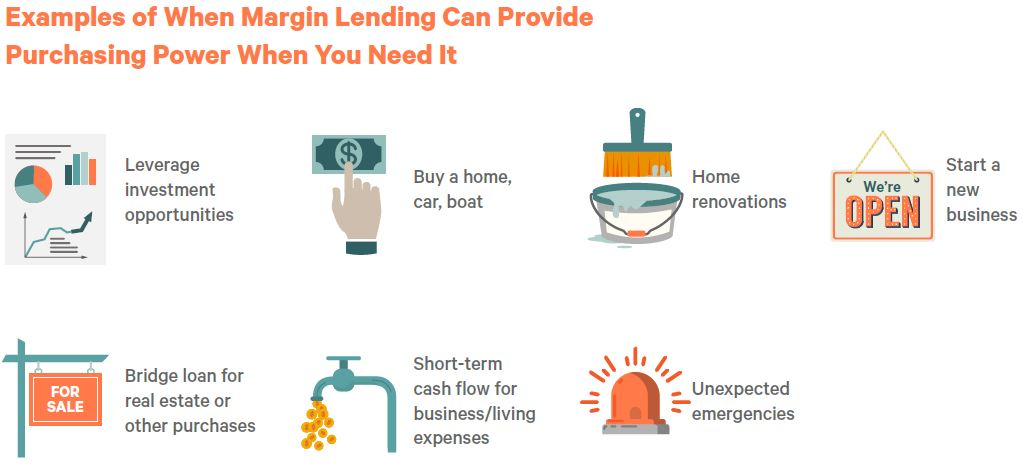We believe a good wealth management strategy prepares for planned and unexpected liquidity needs. In our experience, one of the most flexible liquidity options may be borrowing against the value of your own taxable non-retirement investments versus selling appreciated assets that may trigger an unwelcome taxable event. Securities based lending (SBL) and margin accounts allow investors simple, convenient access to a line of credit using their investments as collateral at what are typically lower interest rates than many other traditional borrowing sources, such as a conventional bank loans, home equity lines of credit or credit cards.
Use the Value of Your Investments to Access Cash Without Selling
Types of taxable non-retirement investments in eligible brokerage and advisory accounts, both discretionary and non-discretionary, that may qualify as collateral include mutual funds, ETFs, stocks and bonds. The amount you can borrow depends on the securities you pledge as collateral and generally works best with well-diversified portfolios. Individuals have two account options available, which have different terms, so depending on your situation, your KAR Wealth Advisor can help you select the most appropriate line of credit for your liquidity needs. SBL accounts allow borrowing against non-retirement assets to establish a line of credit. Margin accounts also allow borrowing against non-retirement assets to establish a line of credit, but also allow the purchase of securities to leverage investment opportunities. SBL and margin loans can be used for many purposes and may prepare you for future and unexpected expenses. Having quick access to credit can help investors avoid selling appreciated assets to raise cash, especially at an inopportune time and depleting the portfolio’s growth potential. During times of historically low interest rates, investment income may be greater than interest costs, making lines of credit an option to meet short-term liquidity needs.

Broad Eligibility, Quick Access, No Fees, Easy Terms
Some reasons SBLs and margin accounts are considered over other loans include broad eligibility, easy approval with limited paperwork, no closing costs or other fees, quick access, and easy repayment terms. A credit check may be required for SBLs, but generally financial statements and tax returns are not part of the simple application process. SBLs and margin accounts are typically considered lower-cost cash flow solutions for clients since securities in investment portfolios serve as collateral and the competitive rates are set as spreads to the 1-month Secured Overnight Financing Rate (SOFR), making the rates lower than most comparable borrowing options. Once the account is approved, which is typically within a few days or less, the investor can access the loan or line immediately or have the peace of mind that it is available at any time in the future when liquidity needs may arise. Repayment terms are flexible in both SBL and margin accounts. Keep in mind that you will not pay any interest to maintain and keep the account open and ready to access when needed. Interest is paid only when funds are advanced from the line.
Know the Risks
Before deciding to borrow against your investment portfolio as a cash solution, it is important to know the risks. As a rule, it is good to borrow less than the maximum available to you in the event of a market downturn. Since SBLs and margin loans are made against the securities in an investment portfolio, they will fluctuate with the market. If the market goes down, the value of your securities may decline and the lender has the right to increase collateral requirements, which may allow the lender, at their discretion, to sell securities in the account to pay off the loan, which can result in unexpected tax consequences. Interest rates also may rise, increasing the cost of the loan. While there is no principal payment schedule, paying the interest as it is charged to the account is recommended to consistently reduce the credit balance. Your KAR Wealth Advisor can help provide a repayment plan that aligns with your financial situation and can also discuss other risks and market scenarios that may impact your long-term goals.

This article is intended to be a brief and simplified introduction to using portfolio securities to access cash and should not be used as the basis for a decision to use line of credit borrowing. It is important to understand the mechanics of securities-based lending and margin accounts to determine whether it’s appropriate for your short-term cash needs and overall investment goals and objectives.
Contact Kayne Anderson Rudnick today to speak with one of our portfolio managers about your investment strategy.
This information is being provided by Kayne Anderson Rudnick Investment Management, LLC (“KAR”) for illustrative purposes only. Information contained in this material is not intended by KAR to be interpreted as investment advice, a recommendation or solicitation to purchase securities, or a recommendation of a particular course of action and has not been updated since the date of the material, and KAR does not undertake to update the information presented should it change. This information is based on KAR’s opinions at the time of the recording of this material and are subject to change based on market activity. There is no guarantee that any forecasts made will come to pass. KAR makes no warranty as to the accuracy or reliability of the information contained herein. The information provided here should not be considered to be tax advice and all investors should consult their tax professional about the specifics of their own tax situation to determine any proper course of action for them. KAR does not provide tax advice and nothing herein should be construed as tax advice, and information presented here may not be true or applicable for all income tax situations. Tax laws can and frequently do change, and KAR does not undertake to update this should any changes occur. Past performance is no guarantee of future results.